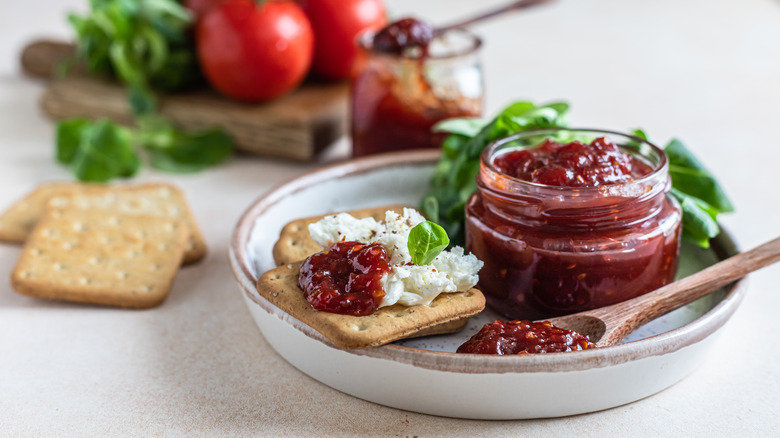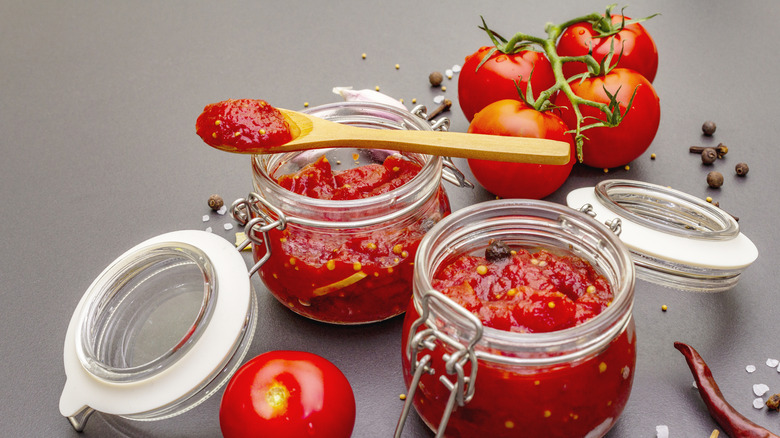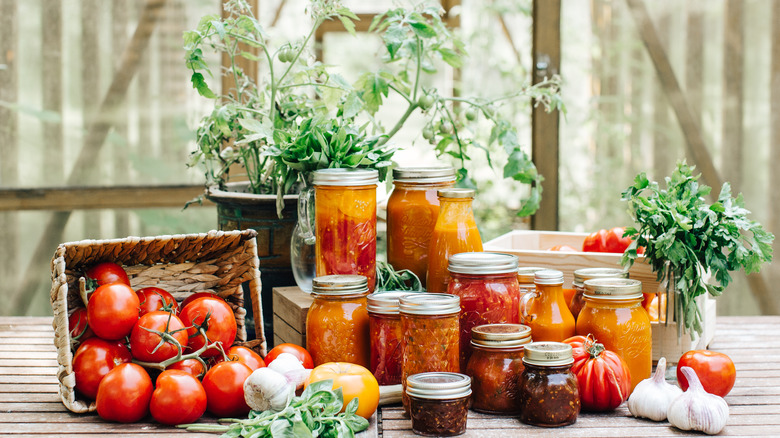What Is Tomato Jam, And What Is It Used For?
We've heard of tomato sauce, tomato puree, tomato paste, and even ketchup. We're more or less familiar with what makes these tomato products different from one another. But what exactly is tomato jam? To answer that question, we need to figure out what "jam" is in the first place. Various dictionaries define jam as being a preserve made of whole fruits that are boiled with sugar. But wait. We're talking about tomatoes. "Fruit"? "With sugar"?
Plenty of people don't realize that tomatoes are botanically classified as fruits, being the berries of the tomato plant. If you've had the pleasure of tasting a vine-ripened tomato, you'll quickly agree with this definition as the natural sweetness of the fruit far exceeds the mealy blandness of many supermarket tomatoes. The reason why we don't chomp on them like we would apples is probably because as sweet as the best tomatoes are, they aren't as high in sugar when compared to many other fruits, thus giving them a more savory flavor.
As for the sugar, it exists in a jam to help set the preserve into a thick, spreadable consistency. Fruits naturally contain a substance called pectin which helps a jam hold together after being cooked, though different fruits contain different levels of pectin. In the case of tomatoes, their high level of pectin means that you won't have to add as much sugar to help the jam set.
How to make tomato jam
Now that we know that tomato jam is indeed a fruit jam like any other, how do we make it? To make about two cups of jam, you will need two pounds of chopped ripe tomatoes, about half a cup of sugar, one to two tablespoons of some kind of acid (apple cider vinegar or lemon juice), salt, and any spices and flavorings that you desire. Combine all of the ingredients in a large, heavy-bottomed pot, preferably an enameled Dutch oven. Turn the heat on medium-high and bring it all to a boil. Once it begins to boil, turn the heat down to medium-low and leave it to simmer for about two hours, giving it a stir once in a while.
To tell if the jam is done, dip a wide spoon into the jam and draw a finger across the surface of the spoon. If the line holds — as in, it doesn't immediately fill back up with juices — it's done. You can also test for its doneness with a freezer test. Put a small plate in the freezer before you get going with jam-making to get it very cold. At the end of the jam-cooking process, drip a spoonful of jam on the surface of the cold plate. If it sets after a couple of seconds, the jam is ready. Tomato jam keeps in the fridge for up to two weeks, or for long-term in the freezer when you need a taste of summer in the depths of winter.
Ideas for flavors and serving suggestions
Once you have your preferred ratio of fruit to acid to sugar, you can have fun with extra flavor components. Do you want a deeply savory jam? Try warm spices like ground cumin and coriander, or spice it up with a dash of chile pepper powders like urfa biber or gochugaru. To give the tomato jam a brighter flavor profile, incorporate lemon zest along with fresh herbs like basil, or even a small amount of grated fresh ginger.
Tomato jam is best served in instances where we would use jams in a more savory application, like on a charcuterie board with mild soft cheeses or even in a pizza. A popular recommendation online for tomato jam is to use it in BLT sandwiches in the winter when good tomatoes are unavailable. We imagine it'll taste excellent dolloped on a jacket potato, giving a modern twist on ketchup and fries. Try it out, experiment with it, and we'll keep summer going with our own homemade batch of tomato jam.


